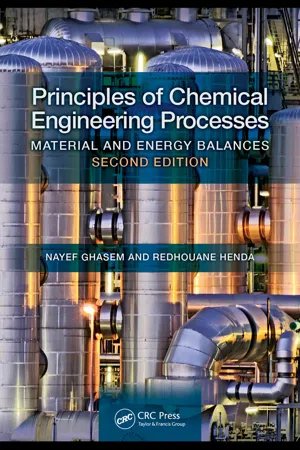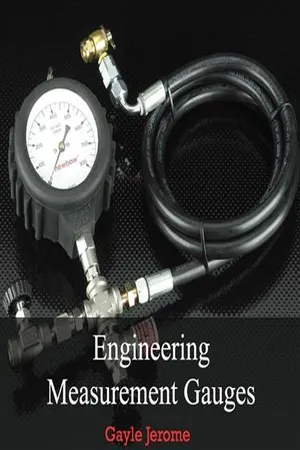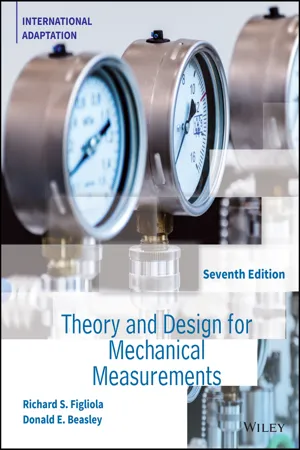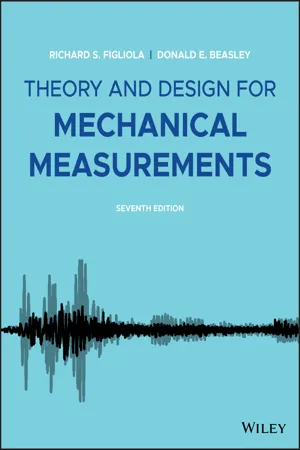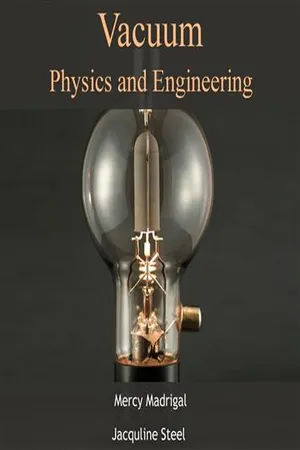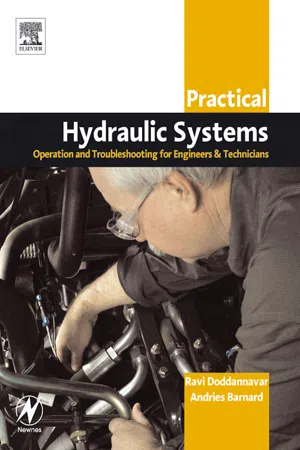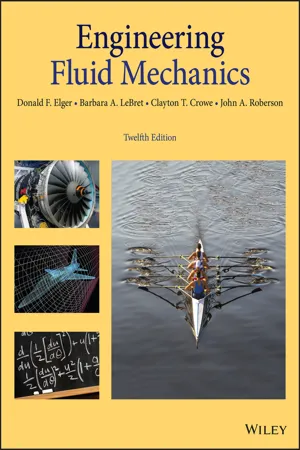Physics
Absolute Pressure and Gauge Pressure
Absolute pressure is the total pressure exerted by a fluid, including atmospheric pressure. It is measured relative to a perfect vacuum. Gauge pressure, on the other hand, measures pressure relative to atmospheric pressure alone. It does not take into account the atmospheric pressure itself.
Written by Perlego with AI-assistance
Related key terms
1 of 5
12 Key excerpts on "Absolute Pressure and Gauge Pressure"
- No longer available |Learn more
Principles of Chemical Engineering Processes
Material and Energy Balances, Second Edition
- Nayef Ghasem, Redhouane Henda(Authors)
- 2014(Publication Date)
- CRC Press(Publisher)
The relationship for converting between absolute and gauge pressure is given by P P P absolute gauge atmospheric = + (1.16) 23 Introduction Pressure is defined as force per unit area. Pressure can be expressed as a rela-tive pressure or absolute pressure. The units of pressure are SI unit N m or Pa 2 : ( ) CGS unit dyn cm 2 : AES unit lb in or psi f 2 : . ( ) Chemical engineers are most often interested in pressures that are caused by a fluid. If a fluid is flowing through a horizontal pipe and a leak develops, a force must be applied over the area of the hole that causes the leak to stop the fluid from leaking. This pressure is called the fluid pressure (the force applied must be divided by the area of the hole). This is schematically shown in Figure 1.3. If a vertical container contains a fluid, the mass of the fluid will exert a force on the base of the container. This pressure is called the hydrostatic pressure. Hydrostatic pressure is the pressure caused by the mass of a fluid, as shown in Figure 1.4. 1.7.1 Types of Pressures 1. Atmospheric pressure, P atm , is the pressure caused by the weight of the earth’s atmosphere. Often atmospheric pressure is called baro-metric pressure. P atm Area, A Force, F Fluid pressure = F / A Height, H FIGURE 1.3 Force on a side hole in an open tank. 24 Principles of Chemical Engineering Processes 2. Absolute pressure, P abs , is the total pressure. An absolute pressure of 0.0 is a perfect vacuum. Absolute pressure must be used in all calcu-lations, unless a pressure difference is used. 3. Gauge pressure, P gauge , is pressure relative to atmospheric pressure. 4. Vacuum pressure, P vac , is a gauge pressure that is below atmospheric pressure. It is used so that a positive number can be reported. Standard atmosphere is defined as the pressure equivalent to 760 mmHg or 1 atm at sea level and at 0°C. - eBook - PDF
Instrument Technology
Measurement of Pressure, Level, Flow and Temperature
- E. B. Jones(Author)
- 2013(Publication Date)
- Butterworth-Heinemann(Publisher)
This is, of course, a differential pressure measurement, the 'gauge pressure' being the difference between the absolute pressure of the fluid and the atmospheric pressure. Therefore: Gauge pressure = absolute pressure of fluid —pressure of the atmosphere, Absolute pressure of fluid = Gauge pressure + pressure of the atmosphere (l.la) In gauges which are sometimes spoken of as indicating vacuum or suction, they are really indicating the amount the absolute pressure of the fluid is less than atmospheric pressure, and Gauge pressure = pressure of atmosphere —pressure of fluid therefore Absolute pressure of fluid = pressure of atmosphere —Gauge pressure (1.1b) 22 MEASUREMENT OF PRESSURE In other forms of differential pressure measurement the gauge is used to measure the difference between the absolute pressures of two samples of the same fluid, or, the difference between the absolute pressures of two fluids. Figure 1.1 shows a U tube used for the various types of pressure measurement. The same principle applies when other forms of pressure measuring elements are used. 1.2 M E T H O D S OF MEASUREMENT OF PRESSURE Pressure may be measured directly in two ways. In the first place, the pressure due to a fluid may be balanced by the pressure produced by a column of liquid of known density. In the second place, the pressure may be permitted to act over a known area, and since Force Pressure = — Area or, Force = Pressure x Area, a force will be produced whose magnitude depends upon the pressure. This force may be measured by balancing it against a known weight, or, by the strain or deformation it produces in an elastic medium. Other methods of measuring pressure depend upon indirect means. Methods of measuring pressure may, therefore, be classified as follows: 1. Pressure measurement by balancing against a column of liquid of known density, Simple U tube with vertical or inclined limb, The simple U tube in practice. - No longer available |Learn more
- (Author)
- 2014(Publication Date)
- Orange Apple(Publisher)
• Gauge pressure is zero referenced against ambient air pressure, so it is equal to absolute pressure minus atmospheric pressure. Negative signs are usually omitted. • Differential pressure is the difference in pressure between two points. The zero reference in use is usually implied by context, and these words are only added when clarification is needed. Tire pressure and blood pressure are gauge pressures by convention, while atmospheric pressures, deep vacuum pressures, and altimeter pressures must be absolute. Differential pressures are commonly used in industrial process systems. Differential pressure gauges have two inlet ports, each connected to one of the volumes whose pressure is to be monitored. In effect, such a gauge performs the mathematical operation of subtraction through mechanical means, obviating the need for an operator or control system to watch two separate gauges and determine the difference in readings. Moderate vacuum pressures are often ambiguous, as they may represent absolute pressure or gauge pressure without a negative sign. Thus a vacuum of 26 inHg gauge is equivalent to an absolute pressure of 30 inHg (typical atmospheric pressure) − 26 inHg = 4 inHg. Atmospheric pressure is typically about 100 kPa at sea level, but is variable with altitude and weather. If the absolute pressure of a fluid stays constant, the gauge pressure of the same fluid will vary as atmospheric pressure changes. For example, when a car drives up a mountain (atmospheric air pressure decreases), the (gauge) tire pressure goes up. Some standard values of atmospheric pressure such as 101.325 kPa or 100 kPa have been defined, and some instruments use one of these standard values as a constant zero reference instead of the actual variable ambient air pressure. This impairs the accuracy of these instruments, especially when used at high altitudes. Use of the atmosphere as reference is usually signified by a (g) after the pressure unit e.g. - Richard S. Figliola, Donald E. Beasley(Authors)
- 2023(Publication Date)
- Wiley(Publisher)
It acts inwardly (compressive) and normally to a surface. A pure vacuum, which contains no molecules, provides the limit for a primary standard for absolute zero pressure. As shown in Figure 9.1, the absolute pressure scale is quantified relative to this absolute zero pressure. The pressure under standard atmospheric conditions is defined as 1.01325 × 10 5 Pa absolute (where 1 Pa = 1 N/m 2 ) at 15 ◦ C [2]. This is equivalent to 101.325 kPa absolute 1 atm absolute 14.696 lb/in. 2 absolute (written as psia) 1.013 bar absolute (where 1 bar = 100 kPa) The term “absolute” might be abbreviated as “a” or “abs.” Also indicated in Figure 9.1 is a gauge pressure scale. The gauge pressure scale is measured relative to some absolute reference pressure, which is defined in a manner convenient to the measurement. The relation between an absolute pressure, p abs , and its corresponding gauge pressure, p gauge , is given by p gauge = p abs − p 0 (9.1) 394 Chapter 9 | Pressure and Velocity Measurements Gauge system pressure 101.325 kPa abs. 14.696 psia 760 mm Hg abs. 29.92 in Hg abs. Local reference pressure System pressure Perfect vacuum Absolute system pressure Absolute reference pressure Standard atmospheric pressure FIGURE 9.1 Relative pressure scales. where p 0 is a reference pressure. A commonly used reference pressure is the local absolute atmospheric pressure. Abso- lute pressure is a positive number. Gauge pressure can be positive or negative depending on the value of measured pressure relative to the reference pressure. A differential pressure, such as p 1 − p 2 , is a relative measure of pressure. Pressure can also be described in terms of the pressure exerted on a surface that is submerged in a column of fluid at depth h, as depicted in Figure 9.2.- Richard S. Figliola, Donald E. Beasley(Authors)
- 2019(Publication Date)
- Wiley(Publisher)
It acts inwardly (compressive) and normally to a surface. A pure vacuum, which contains no molecules, provides the limit for a primary standard for absolute zero pressure. As shown in Figure 9.1, the absolute pressure scale is quantified rela- tive to this absolute zero pressure. The pressure under standard atmospheric conditions is defined as 1.01325 × 10 5 Pa absolute (where 1 Pa = 1 N/m 2 ) at 15 ∘ C [2]. This is equivalent to 101.325 kPa absolute 1 atm absolute 315 316 PRESSURE AND VELOCITY MEASUREMENTS FIGURE 9.1 Relative pressure scales. Gauge system pressure 101.325 kPa abs. 14.696 psia 760 mm Hg abs. 29.92 in Hg abs. Local reference pressure System pressure Perfect vacuum Absolute system pressure Absolute reference pressure Standard atmospheric pressure 14.696 lb/in. 2 absolute (written as psia) 1.013 bar absolute (where 1 bar = 100 kPa) The term “absolute” might be abbreviated as “a” or “abs.” Also indicated in Figure 9.1 is a gauge pressure scale. The gauge pressure scale is measured relative to some absolute reference pressure, which is defined in a manner convenient to the mea- surement. The relation between an absolute pressure, p abs , and its corresponding gauge pressure, p gauge , is given by p gauge = p abs − p 0 (9.1) where p 0 is a reference pressure. A commonly used reference pressure is the local absolute atmospheric pressure. Absolute pressure is a positive number. Gauge pressure can be positive or negative depending on the value of measured pressure relative to the reference pressure. A dif- ferential pressure, such as p 1 − p 2 , is a relative measure of pressure. Pressure can also be described in terms of the pressure exerted on a surface that is submerged in a column of fluid at depth h, as depicted in Figure 9.2. From hydrostatics, the pressure at any depth within a fluid of specific weight γ can be written as p abs (h) = p(h 0 ) + γh = p 0 + γh (9.2) FIGURE 9.2 Hydrostatic-equivalent pressure head and pressure.- No longer available |Learn more
- (Author)
- 2014(Publication Date)
- Academic Studio(Publisher)
• Gauge pressure is zero referenced against ambient air pressure, so it is equal to absolute pressure minus atmospheric pressure. Negative signs are usually omitted. • Differential pressure is the difference in pressure between two points. The zero reference in use is usually implied by context, and these words are only added when clarification is needed. Tire pressure and blood pressure are gauge pressures by convention, while atmospheric pressures, deep vacuum pressures, and altimeter pressures must be absolute. Differential pressures are commonly used in industrial process systems. Differential pressure gauges have two inlet ports, each connected to one of the volumes whose pressure is to be monitored. In effect, such a gauge performs the mathematical operation of subtraction through mechanical means, obviating the need for an operator or control system to watch two separate gauges and determine the difference in readings. Moderate vacuum pressures are often ambiguous, as they may represent absolute pressure or gauge pressure without a negative sign. Thus a vacuum of 26 inHg gauge is equivalent to an absolute pressure of 30 i nHg (typical atmospheric pressure) − 26 inHg = 4 inHg. Atmospheric pressure is typically about 100 kPa at sea level, but is variable with altitude and weather. If the absolute pressure of a fluid stays constant, the gauge pressure of the same fluid will vary as atmospheric pressure changes. For example, when a car drives up a mountain (atmospheric air pressure decreases), the (gauge) tire pressure goes up. Some standard values of atmospheric pressure such as 101.325 kPa or 100 kPa have been defined, and some instruments use one of these standard values as a constant zero reference instead of the actual variable ambient air pressure. This impairs the accuracy of these instruments, especially when used at high altitudes. Use of the atmosphere as reference is usually signified by a (g) after the pressure unit e.g. - No longer available |Learn more
- (Author)
- 2014(Publication Date)
- Library Press(Publisher)
• Gauge pressure is zero referenced against ambient air pressure, so it is equal to absolute pressure minus atmospheric pressure. Negative signs are usually omitted. • Differential pressure is the difference in pressure between two points. The zero reference in use is usually implied by context, and these words are only added when clarification is needed. Tire pressure and blood pressure are gauge pressures by convention, while atmospheric pressures, deep vacuum pressures, and altimeter pressures must be absolute. Differential pressures are commonly used in industrial process systems. Differential pressure gauges have two inlet ports, each connected to one of the volumes whose pressure is to be monitored. In effect, such a gauge performs the mathematical operation of subtraction through mechanical means, obviating the need for an operator or control system to watch two separate gauges and determine the difference in readings. Moderate vacuum pressures are often ambiguous, as they may represent absolute pressure or gauge pressure without a negative sign. Thus a vacuum of 26 inHg gauge is equivalent to an absolute pressure of 30 inHg (typical atm ospheric pressure) − 26 inHg = 4 inHg. Atmospheric pressure is typically about 100 kPa at sea level, but is variable with altitude and weather. If the absolute pressure of a fluid stays constant, the gauge pressure of the same fluid will vary as atmospheric pressure changes. For example, when a car drives up a mountain (atmospheric air pressure decreases), the (gauge) tire pressure goes up. Some standard values of atmospheric pressure such as 101.325 kPa or 100 kPa have been defined, and some instruments use one of these standard values as a constant zero reference instead of the actual variable ambient air pressure. This impairs the accuracy of these instruments, especially when used at high altitudes. Use of the atmosphere as reference is usually signified by a (g) after the pressure unit e.g. - eBook - ePub
- G. M. S. de Silva(Author)
- 2012(Publication Date)
- Routledge(Publisher)
gauge pressures. The difference between a pressure higher than atmospheric and atmospheric pressure is a positive gauge pressure, while the difference between atmospheric pressure and a pressure lower than atmospheric is referred to as negative gauge pressure or vacuum. Gauge pressure values being dependent on atmospheric pressure change slightly as the ambient pressure changes.The relationship between absolute and gauge pressure is given below:Absolute pressure = gauge pressure + atmospheric pressure (5.1) A differential pressure is the difference of pressure values at two distinct points in a system. For example, the flow of a fluid across a restriction in a pipe causes a pressure differential and this is used to determine the flow of the gas or liquid. This is the principle of the orifice plate as shown in Fig. 5.2 .5.4 Primary standards
A number of different physical standards are used for the realization of pressure values at the primary level. The two most common instruments for the positive gauge pressure range are the mercury manometer and dead weight pressure tester. The spinning ball gauge standard is used in the negative gauge pressure (vacuum) range.Figure 5.1 Pressure modes and their relationshipsFigure 5.2 Differential pressure in an orifice plate5.4.1 Mercury manometer
The basic principle of the mercury manometer is illustrated in Fig. 5.3 . Vessels A and B are connected using a flexible tube. Vessel A is at a fixed level while vessel B can be moved up and down using a lead screw mechanism. The output pressure is obtained from vessel A.A vacuum pump is sometimes used to evacuate the air above the meniscus of the moving vessel. Under these conditions the output pressure Pout - Ravi Doddannavar, Andries Barnard, Jayaraman Ganesh(Authors)
- 2005(Publication Date)
- Newnes(Publisher)
Air has mass and due to the effect of gravity exerts a force called weight. The force per unit area is called pressure. This pressure exerted on the earth’s surface is known as atmospheric pressure. Gage pressure Most pressure-measuring instruments measure the difference between the pressure of a fluid and the atmospheric pressure. This is referred to as gage pressure. Absolute pressure Absolute pressure is the sum of the gage pressure and the atmospheric pressure. Vacuum If the pressure is lower than the atmospheric pressure, its gage pressure is negative and the term vacuum is used when the absolute pressure is zero (i.e. there is no air present whatsoever). = 0 P Figure 2.2 Relationship between absolute, gage and vacuum pressure In Figure 2.2, P a is the atmospheric pressure, P gage is the gage pressure, P ab is the absolute pressure and P vacuum is the vacuum pressure. 2.2.4 Effect of pressure on boiling point The boiling point of a liquid increases with an increase in pressure while conversely decreasing with a decrease in pressure. Thus if the atmospheric pressure is more than 14.7 psi or 101.3 kPa, water boils at a temperature higher than 100 ° C (212 ° F). Similarly water boils at a lower temperature if the pressure is lower than 14.7 psi or 101.3 kPa. Pressure and flow 19 At boiling point, the pressure of the vapors at the liquid surface is equal to the external atmospheric pressure. Thus if the external atmospheric pressure increases, the liquid has to boil at a higher temperature to create a vapor pressure equal to the external pressure. At higher altitudes, the atmospheric pressure is low, hence water boils at a temperature lower than 100 ° C (212 ° F). This makes cooking difficult. An important point to be noted is that adding impurities to a liquid can increase its boiling point. 2.2.5 Pressure measurement The behavior of a fluid can be deduced by measuring the two critical system parameters of flow and pressure.- eBook - PDF
Mechanical Measurements
Jones' Instrument Technology
- B E Noltingk(Author)
- 2016(Publication Date)
- Butterworth-Heinemann(Publisher)
9 Measurement of pressure E. H. HIGHAM 9.1 What is pressure? When a fluid is in contact with a boundary it produces a force at right angles to that boundary. The force per unit area is called the pressure. In the past, the distinction between mass and force has been blurred because we live in an environment in which every object is subjected to gravity and is accelerated towards the centre of the earth unless restrained. As explained in Chapter 8, the confusion is avoided in the SI system of units (Systeme International d'Unites) where the unit of force is the newton and the unit of area is a square metre so that pressure, being force per unit area, is measured in newtons per square metre and the unit, known as the pascal, is independent of the acceleration due to gravity. The relation between the pascal and other units used for pressure measurements is shown in Table 9.1. There are three categories of pressure measure-ments, namely absolute pressure, gauge pressure and differential pressure. The absolute pressure is the difference between the pressure at a particular point in a fluid and the absolute zero of pressure, i.e. a complete vacuum. A barometer is one example of an absolute pressure gauge because the height of the column of mercury measures the difference between the atmospheric pressure and the 'zero' pressure of the Torricellian vacuum that exists above the mercury column. When the pressure-measuring device measures the difference between the unknown pressure and local atmospheric pressure the measurement is known as gauge pressure. When the pressure-measuring device measures the difference between two unknown pressures, neither of which is atmospheric pressure, then the measurement is known as the differential pressure. A mercury manometer is used in Figure 9.1 to illustrate these three measurements. 9.2 Pressure measurement There are three basic methods for pressure measure-ment. - eBook - PDF
- Raymond Serway, Chris Vuille(Authors)
- 2017(Publication Date)
- Cengage Learning EMEA(Publisher)
The pressure at point B equals P 0 1 rgh, where r is the density of the fluid. The pressure at B, however, equals the pressure at A, which is also the unknown pressure P. We conclude that P 5 P 0 1 rgh. The pressure P is called the absolute pressure, and P 2 P 0 is called the gauge pressure. If P in the system is greater than atmospheric pressure, h is positive. If P is less than atmospheric pressure (a partial vacuum), h is negative, meaning that the right-hand column in Figure 9.13a is lower than the left-hand column. Another instrument used to measure pressure is the barometer (Fig. 9.13b), invented by Evangelista Torricelli (1608–1647). A long tube closed at one end is filled with mercury and then inverted into a dish of mercury. The closed end of the tube is nearly a vacuum, so its pressure can be taken to be zero. It follows that P 0 5 rgh, where r is the density of the mercury and h is the height of the mercury column. Note that the barometer measures the pressure of the atmosphere, whereas the manometer measures pressure in an enclosed fluid. One atmosphere of pressure is defined to be the pressure equivalent of a column of mercury that is exactly 0.76 m in height at 0°C with g 5 9.806 65 m/s 2 . At this temperature, mercury has a density of 13.595 3 10 3 kg/m 3 ; therefore, P 0 5 rgh 5 (13.595 3 10 3 kg/m 3 )(9.806 65 m/s 2 )(0.760 0 m) 5 1.013 3 10 5 Pa 5 1 atm It’s interesting to note that the force of the atmosphere on our bodies (assum- ing a body area of 2 000 in. 2 ) is extremely large, on the order of 30 000 lbs! If it were not for the fluids permeating our tissues and body cavities, our bodies would collapse. The fluids provide equal and opposite forces. In the upper atmosphere or in space, sudden decompression can lead to serious injury and death. Air retained in the lungs can damage the tiny alveolar sacs, and intestinal gas can even rupture internal organs. Quick Quiz 9.3 Several common barometers are built using a variety of fluids. - eBook - PDF
- Donald F. Elger, Barbara A. LeBret, Clayton T. Crowe, John A. Roberson(Authors)
- 2019(Publication Date)
- Wiley(Publisher)
If a gage pressure is 0.55 bar, what is absolute pressure in psi? d. If a person’s blood pressure is 119 mm Hg gage, what is their blood pressure in kPa abs? 3.7 A 93-mm diameter sphere contains an ideal gas at 20°C. Apply the grid method to calculate the density in units of kg/m 3 . a. The gas is helium. The gage pressure is 36 in H 2 O. b. The gas is methane. The vacuum pressure is 8.8 psi. 3.8 For the questions below, assume standard atmospheric pressure. a. For a vacuum pressure of 43 kPa, what is the > Answer absolute pressure? Gage pressure? b. For a pressure of 15.6 psig, what is the pressure in psia? c. For a pressure of 190 kPa gage, what is the absolute pressure in kPa? d. Give the pressure 100 psfg in psfa. 3.9 The local atmospheric pressure is 91 kPa. A gage on an oxy- gen tank reads a pressure of 250 kPa gage. What is the pressure in the tank in kPa abs? 3.10 (T/F) The gage pressure at a depth of 34 meters of water is about 1 bar. > Answer 3.11 The gage tester shown in the figure is used to calibrate or to test pressure gages. When the weights and the piston together weigh 132 N, the gage being tested indicates 197 kPa. If the piston diameter is 30 mm, what percentage of error exists in the gage? Weights Piston Air Oil Problem 3.11 3.12 As shown, a mouse can use the mechanical advantage pro- vided by a hydraulic machine to lift up an elephant. > Answer a. Derive an algebraic equation that gives the mechanical advantage of the hydraulic machine shown. Assume the pistons are frictionless and massless. b. A mouse can have a mass of 25 g and an elephant a mass of 7500 kg. Determine a value of D 1 and D 2 so that the mouse can support the elephant. Hydraulic fluid Piston (two places) Mouse with mass m 1 Elephant with mass m 2 D 2 D 1 Problem 3.12 Chapter 3 Problems P-14 CHAPTER 3 • FLUID STATICS 3.13 A point is located at an elevation of 3 km in the atmosphere. In SI units, what are the properties as given by the standard atmosphere model? a.
Index pages curate the most relevant extracts from our library of academic textbooks. They’ve been created using an in-house natural language model (NLM), each adding context and meaning to key research topics.
